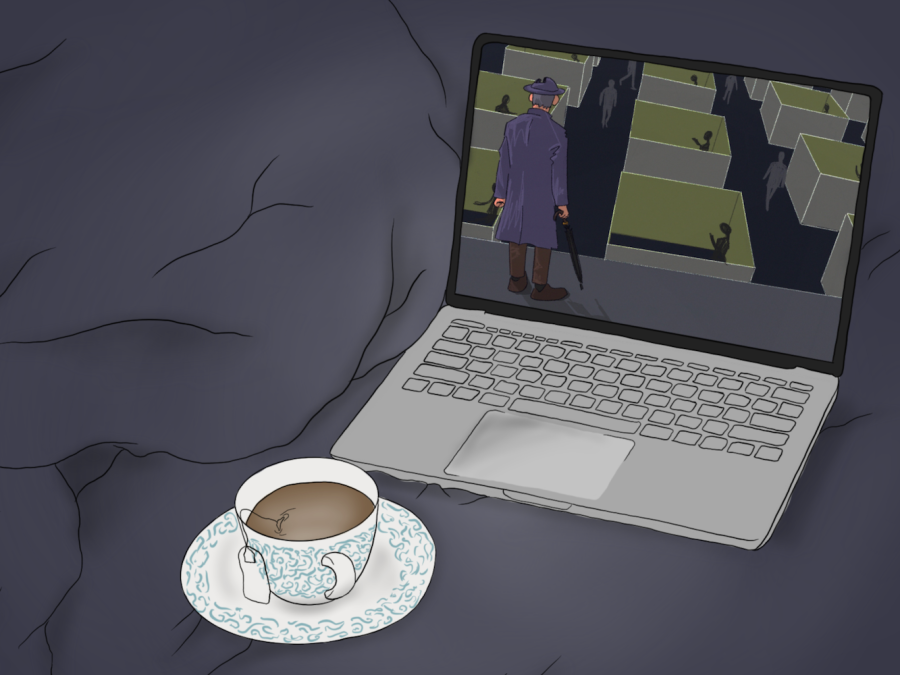Off the Radar: ‘PlayTime’ and the baffling nature of industrialization
Off the Radar is a weekly column surveying overlooked films available to students for free via NYU’s streaming partnerships. “PlayTime” is available to stream on Kanopy and will screen at Film at Lincoln Center on April 16.
(Illustration by Aaliya Luthra and Nicole Lin)
April 14, 2023
Renowned French filmmaker Jacques Tati, most famous for Monsieur Hulot, his clumsy persona, crafted one of the most technically ambitious and conceptually timeless films with 1967’s monumental “PlayTime.”
In “PlayTime,” Tati envisions a convoluted, ultra-modern setting in which old-fashioned Monsieur Hulot fumbles around trying to make sense of it all, much like in his previous film, “Mon Oncle.” While that film focused its commentary on industrialization toward one technologically advanced Parisian home, “PlayTime” demonstrates its ingenuity by framing ultra-modernism with all of Paris. The film’s wildly impressive set design, immaculate cinematography and use of extras allow for some of Tati’s greatest visual gags — a number of which happen within the span of a single frame.
The incredibly ambitious production of “PlayTime” adds nuance and artistry to the overall theme of puzzlement in the film. This is cleverly seen through the film sets’ elaborate architecture, such as the pristine airport at the beginning and the iconic, maze-like office space in which Hulot constantly finds himself getting lost. Tati’s use of glass and steel buildings to baffle his characters cements the confusion present.
“PlayTime” often deploys characters who look exactly like Hulot as a means of tricking both its characters and its viewers. Throughout the film, Hulot is actively trying to piece everything together the same way that the audience is.
Tati’s film also focuses heavily on how culture is changing — how modernism and industrialization could affect one’s perception of the world’s authenticity. Even though the entire film is set in Paris, the audience only ever gets to see its most famous landmark, the Eiffel Tower, twice in the film: once through a landscape shot of the tower being buried by overpowering fog and pollution, and another time through a reflection of a spotless glass door — and even so, the reflection itself is overwhelmed by towering skyscrapers. This isn’t a traditional tour of Paris, as the film’s characters are exposed almost solely to products — modern glasses, silent doors, overly fancy restaurants and trash cans resembling the columns of Ancient Greece — whose striking presentation conceals their hilarious absurdity.
“PlayTime” presents a futuristic dystopia that subtly critiques ultra-modernism for its entire duration, achieving this thanks to its confusing and convoluted depiction. With that said, it is important to note that Tati uses the film’s last five minutes to fill the scenery with joyful hope for the future. The beautiful — and genuinely masterful — soundtrack adds a surprising amount of energy for a film that, at first, seems very cynical in its approach to industrialization. As valuable as culture and history are, the film’s ending, in which technological innovations are being presented with optimism, elicits a sense of gratitude for the world Tati envisioned.
The film is brimful of many different things happening all at once within every single frame. Yet, it is somehow also one of the most organized, meticulous and visually appealing films in cinematic history. Tati’s masterpiece will continue to both break boundaries and demonstrate its relevance with its timeless nature.
“PlayTime” is available to stream on Kanopy and will screen at Film at Lincoln Center on April 16.
Contact Yezen Saadah at [email protected].

























































































































































